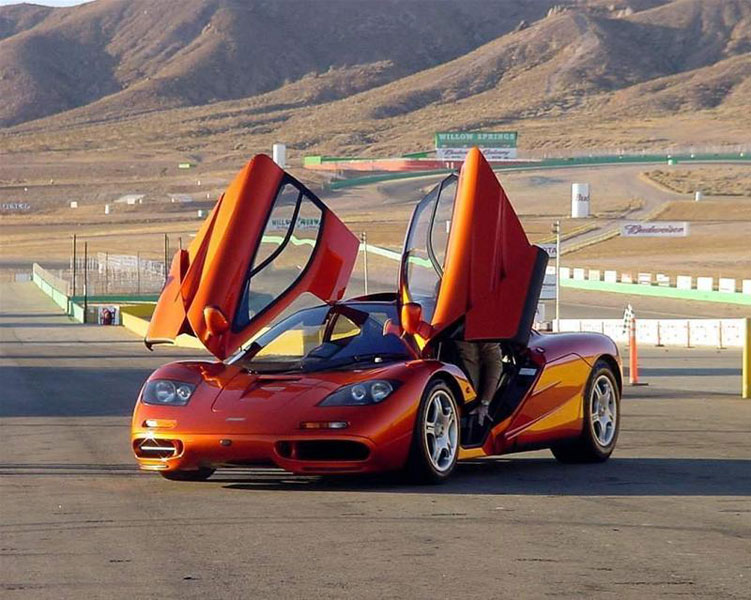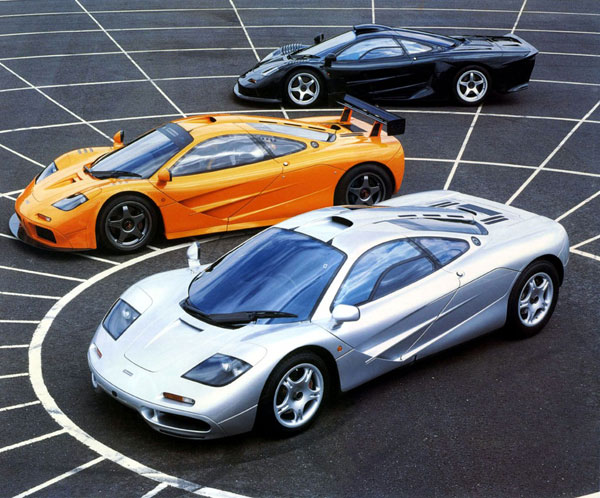It’s almost impossible to look past the McLaren F1 when talking about the greatest ever supercars – produced throughout the 1990s, it’s still today one of the fastest, most expensive and most technically astounding production cars ever made.
Dreamed up by Gordon Murray, best known for designing Formula 1 cars throughout the 70s and 80s and for serving as McLaren’s Technical Director when Ayrton Senna secured his first Drivers’ Championship, the McLaren F1 was designed from the beginning to be the ultimate road car.

With Murray’s background in Formula 1, and with designer Peter Stevens (responsible for the Jaguar XJR-15 and ‘87 Lotus Esprit) lending a hand with the blueprints, however, the McLaren F1 was never going to look much like an average road car from the 1990s.
Instead, the F1 was revealed to the world in 1992 dripping with innovative design quirks and packed with enough power to blow away any of its contemporaries. Utilising a 6.1-litre V12 engine built by BMW that produced a staggering 620bhp, and weighing in at just 1138kg, the final iteration of the F1 was capable of shifting from 0-60 in just 3.2 seconds and could reach a top speed of 240mph, a production car record it would hold until the Bugatti Veyron stole its crown in 2005.
Test driving back in 1994, Autocar said: “The F1 is a car which, no matter how often you drive it, no matter how skilled you are, will always be capable of showing you something undiscovered, something you didn’t believe a road car could manage.” And with those performance stats backing it up, it isn’t hard to see why.
It wasn’t just in raw power that the F1 excelled though. Making use of high-end materials – the world’s first carbon fibre monocoque chassis on a production car and a gold-lined engine bay for example – coupled with precision engineering and an obsessive attention to detail, McLaren squeezed out every last drop of performance, style and handling precision from the car’s construction.
Sheer performance was never the end goal for the F1 however, and on the interior the car came fully equipped with air conditioning, electric windows, a CD player and even luggage space by the two leather passenger seats – a comfortable nod towards Murray’s stated aim of producing a road car, not a track car.

As a hybrid of the two, the McLaren provides almost unmanageable power coupled with enough comfort and style to let it stand above the barebones racers that struggled to achieve similar performance at the time. And while the F1’s jet-fighter-like central driving seat offers unmatched control at the wheel, as well as a fantastic view of the road, the practicality of keeping a lid on 620bhp in a car barely heavier than a Fiat 500 makes it unlikely any lucky owners will be using it as their daily driver.
With the attention to detail and engineering precision needed to achieve its aims, each F1 took on average around eight months to build, and when production halted in 1998 just 106 had left the factory. Of that number, only 65 road-going examples ever reached the public, with the remainder being a series of prototypes, GT homologation efforts and finely tuned Le Mans models – many of which remain in McLaren’s hands today.
If you fancy joining the elite group of F1 owners, which counts the Sultan of Brunei, Elon Musk, and car-fanatic Jay Leno among its members, you’d best be prepared to part with a lot of money. When Rowan Atkinson sold his F1 in 2015 it fetched £8 million, and a 1998 LM model went for £9 million at auction the same year.
For those of us who might never get to sit in one of the greatest road cars of all time, here’s Jay Leno describing what they’re like to drive:

